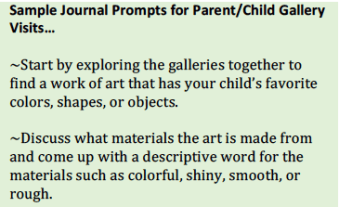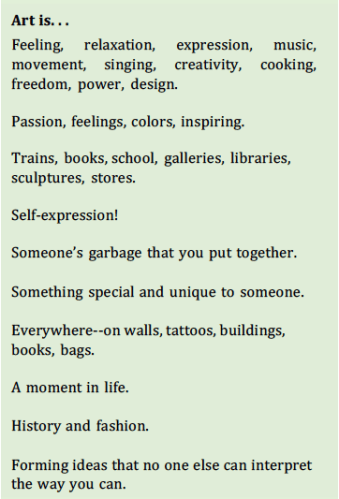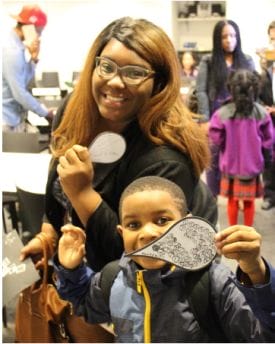
by Dawn Brooks-Decosta, Francis Estrada, and Erin K. Hylton
In the summer of 2014, education staff from the Museum of Modern Art (MoMA) and The Studio Museum in Harlem in New York City discussed the possibility of creating a collaborative program for a school where both institutions had ongoing educational partnerships: Thurgood Marshall Academy Lower School in Harlem. The school, which serves over 200 kindergarten to 5th-grade students, values parent partnerships and collaborative efforts with various community-based organizations within and outside the Harlem community. Both MoMA and The Studio Museum have been working with the school’s teachers and students for several years, providing guided school tours and hosting family days when educators led intergenerational family tours, but we wanted to deepen parent involvement. The goals of both museums included increasing visual arts literacy for the entire family and providing parents opportunities to gain an understanding of what their children learn and experience through arts-based conversations and activities. Using skills essential to museum-based educators, the staff modeled their practices for engaging in conversations around works of art, which provided an opportunity for parents to take more initiative to engage in the arts and feel confident visiting art and cultural institutions independently.
With support from the school’s principal, Dawn Brooks-Decosta (a co-author of this article), and Thurgood Marshall parent leaders, the Cultural Ambassadors Program launched with a workshop at The Studio Museum in October 2014 with more than 15 families. We led an inquiry-based gallery conversation around artworks by Charles Gaines (Gridwork 1974–1989) for 20 parents and family members. We discussed his artistic process and imagined what narratives can be drawn from the images he chose to present. The group conversation flowed smoothly, and parents expressed appreciation for casual exchanges with the educator. Following the gallery experience, we shared our goals and gave participants tasks to complete before our next workshop in April. We asked them to visit a museum with their children before April. We also gave them journals that included simple prompts to help start observational conversations about works of art (see inset).
 The second workshop, conducted at MoMA in April 2015, centered on works from Jacob Lawrence’s Migration Series, with a focus on narratives. Sixteen parents and 20 students participated. Our goal was to foster oral communication of intergenerational experiences by children and adults in their community inspired by Lawrence’s art and process. In the months leading up to this workshop, students visited the museum with their classes and during guided tours investigated how Lawrence’s works depicted environments, people, and conditions throughout the Great Migration.
The second workshop, conducted at MoMA in April 2015, centered on works from Jacob Lawrence’s Migration Series, with a focus on narratives. Sixteen parents and 20 students participated. Our goal was to foster oral communication of intergenerational experiences by children and adults in their community inspired by Lawrence’s art and process. In the months leading up to this workshop, students visited the museum with their classes and during guided tours investigated how Lawrence’s works depicted environments, people, and conditions throughout the Great Migration.
During the workshop, parents were led through an activity-based tour of One Way Ticket while their children remained in a classroom to work on a drawing activity. Before seeing the Migration Series, we provided parents captions that Lawrence used as titles, and then we asked them to draw an image based on the text they received. Upon seeing the associated paintings, we asked them to compare and contrast their drawings with Lawrence’s paintings, considering the artist’s choices, text and image comparisons, and overall reactions to his works. Connections to their own family histories and the current Harlem community sprang from conversations about the artwork on display. Parents responded to the artwork by telling their family narratives of migration from the South and immigration from the Caribbean. As each parent shared, others supported the conversation by adding smiles and nods in agreement. Some chimed in, “My family too!” or “I remember that place!” When it was time to rejoin the children in the workshop, parents continued sharing with each other as we headed to the elevator and down the stairs. They were brimming with excitement as they joined their children.
 In the classroom, taking inspiration from Jacob Lawrence’s narrative process, we asked each child to draw a recent memory from their neighborhood. When parents returned from the galleries, we asked the children to describe their drawing/memory in detail to their parents. Noting Lawrence’s use of captions, we asked parents to write captions for the drawings. The room was full of energy as family members recounted their memories, noting details about their individual experiences that related to the drawings. The children were eager to share their newly captioned drawings and memories with the large group. We noticed that parents shared what they experienced in the galleries with their children, and children shared their experiences from their fieldtrip. Conversations about coming back to visit our institutions and doing art at home filled the classroom. Families expressed enthusiasm about the opportunity to engage in art education beyond the school year, create projects at home, and share their family stories.
In the classroom, taking inspiration from Jacob Lawrence’s narrative process, we asked each child to draw a recent memory from their neighborhood. When parents returned from the galleries, we asked the children to describe their drawing/memory in detail to their parents. Noting Lawrence’s use of captions, we asked parents to write captions for the drawings. The room was full of energy as family members recounted their memories, noting details about their individual experiences that related to the drawings. The children were eager to share their newly captioned drawings and memories with the large group. We noticed that parents shared what they experienced in the galleries with their children, and children shared their experiences from their fieldtrip. Conversations about coming back to visit our institutions and doing art at home filled the classroom. Families expressed enthusiasm about the opportunity to engage in art education beyond the school year, create projects at home, and share their family stories.
At the end of the workshop, we asked parents to complete an electronic survey about their experiences looking at art with their children. The group recorded a high level of comfort engaging in the arts with their children. Given that Thurgood Marshall is a school very focused on the arts in interdisciplinary ways, it is perhaps not surprising that parents show such a high interest in the arts. Ninety-four percent said they were either “comfortable” or “very comfortable” taking their children to an art museum. If parents are open to the arts, their children tend to be more receptive as well. Below are a few parents’ responses when asked if they noticed any changes in their children based on their experience visiting MoMA:
My children are able to discuss art pieces with ease and intelligence. The best thing is that my daughter is a lot less critical of her own artwork.
[My child] is open to discussion and [it’s] great to see my child’s perspective.
Loved the experience. She wants to take the whole family.
We decided to continue the Cultural Ambassadors Program through the 2015-2016 school year because of the success reaching our goals in the previous year and the school’s invitation to return. New families joined the dialogue and experience, as the program was recommended to them by the administrators and former parent participants.
Similar to the previous year, parents and children were split in two separate groups. Parents engaged in inquiry about the works of art as a springboard for conversations about the changing Harlem community. As parents identified places they recognized from the photos, they reminisced about whom they spent most of their time with, the things they did, and what different places in Harlem meant to them. Many places in the photographs no longer exist. Parents noted, “I used to go there with my cousins” or “I remember passing there all the time on my way to 125th Street.” Chimes of agreement and personal stories rang through the gallery as the parents moved among the and should photographs. Stories of past and present intertwined as the base of a discussion about what art could represent for a community.
Our theme was “Art Is…” with a focus on the school community. Beginning at The Studio Museum in Harlem in October with 18 families, we viewed Lorraine O’Grady: Art Is, which centered on a performance by the artist and 15 collaborators during the African American Day Parade in Harlem in 1983. O’Grady entered her float with an enormous, ornate gilded frame displayed on top, and the words “Art Is…” emblazoned on the float’s decorative skirt. At various points along the route, O’Grady and her collaborators jumped off the float and held up empty, gilded picture frames, inviting people to pose in them. The joyful responses turned parade onlookers into participants, affirmed the readiness of Harlem’s residents to see themselves as works of art, and created an irreplaceable record of the people and places of Harlem some 30 years ago.
 While parents were in the galleries, children created their artistic interpretations of what “art is” using markers and worksheets to draw freely and color their interpretation of the phrase. Later, with their parents, they completed the phrase “art is…” in connection to the exhibition and discussed where they could continue to engage in art with their families. Parents offered valuable insight into what “art Is…” and pondered questions such as “What is art? Who defines what art is? How might you become a piece of art? Where might you create work? How do you use creative expression?” The classroom was abuzz as parents and children talked about what “art is…,” and happily transcribed and shared their thoughts with each other.
While parents were in the galleries, children created their artistic interpretations of what “art is” using markers and worksheets to draw freely and color their interpretation of the phrase. Later, with their parents, they completed the phrase “art is…” in connection to the exhibition and discussed where they could continue to engage in art with their families. Parents offered valuable insight into what “art Is…” and pondered questions such as “What is art? Who defines what art is? How might you become a piece of art? Where might you create work? How do you use creative expression?” The classroom was abuzz as parents and children talked about what “art is…,” and happily transcribed and shared their thoughts with each other.

 When the Thurgood Marshall families returned to MoMA six months later, parents had a guided tour of the exhibition From the Collection: 1960–1969 while the children remained in the classroom for a guided activity. Continuing with the theme “art in the community,” the focus was on artists’ use of familiar objects. At first, parents were apprehensive about discussing abstraction, but they began to open up when discussing materials and processes. Discussions in the galleries became lively as parents reflected on what art is, how art could be found in their immediate vicinities, what the artworks represented, and how materials and objects found around their communities were transformed. Interpersonal stories, memories, and shared experiences had parents laughing and connecting with one another as artwork and design objects from the time period evoked memories of their community, family, and Harlem. Parents shared memories of which works resonated with them, of which times in their lives the artwork reminded them, and the role art has had in their lives.
When the Thurgood Marshall families returned to MoMA six months later, parents had a guided tour of the exhibition From the Collection: 1960–1969 while the children remained in the classroom for a guided activity. Continuing with the theme “art in the community,” the focus was on artists’ use of familiar objects. At first, parents were apprehensive about discussing abstraction, but they began to open up when discussing materials and processes. Discussions in the galleries became lively as parents reflected on what art is, how art could be found in their immediate vicinities, what the artworks represented, and how materials and objects found around their communities were transformed. Interpersonal stories, memories, and shared experiences had parents laughing and connecting with one another as artwork and design objects from the time period evoked memories of their community, family, and Harlem. Parents shared memories of which works resonated with them, of which times in their lives the artwork reminded them, and the role art has had in their lives.
While parents were in the galleries, we asked the children to speak with each other and think of places in their communities (home or school) where they see art. Their responses varied from architecture to public art, tattoos, and activities. When the parents returned, they commented on how artists such as John Chamberlain and Lee Bontecou “transformed everyday objects into works of art.” The children talked about where and what types of art they see in their communities, and the responses from the families evoke sentiments ranging from the everyday to the profound.
Next year, in addition to organizing their scheduled guided school tours, we plan to provide students with guided activities in the galleries on the days when their parents visit so that both parties will have gallery experiences when they are in the museum.
We asked Dawn Brooks-Decosta, principal of Thurgood Marshall Academy Lower School, to share her thoughts on the program:
The Cultural Ambassadors Program at Thurgood Marshall Academy Lower School through a unique partnership between MoMA and The Studio Museum in Harlem has provided a special opportunity at our school in building the school-family partnership. The design of the project has provided leadership opportunities for our parents and grandparents to participate directly in the arts integration that exists in our curriculum in a hands-on way. The families have been exposed to works of arts at two major cultural institutions and have received the type of workshop training that is typically used for teachers. This has afforded our parents and grandparents an opportunity they would have otherwise on experienced. The parent and grandparent participants are now leaders in our school throughout this Cultural Ambassadors Program and open to utilizing the museums as places for learning for their families. It is a unique opportunity for which we are eternally grateful.
 Starting out as a pilot program to get more parent involvement from our partnership school, the Cultural Ambassadors Program ultimately allowed parents and their children to communicate orally and visually about their experiences and memories of their communities. Looking at art and having conversations about artists’ processes allowed participants to make connections between art and community, and also created opportunities for deeper engagement and learning for the school and museum partners.
Starting out as a pilot program to get more parent involvement from our partnership school, the Cultural Ambassadors Program ultimately allowed parents and their children to communicate orally and visually about their experiences and memories of their communities. Looking at art and having conversations about artists’ processes allowed participants to make connections between art and community, and also created opportunities for deeper engagement and learning for the school and museum partners.
All photos by Francis Estrada.
Dawn Brooks-Decosta has an MEd in Educational Leadership from Teachers College, Columbia University; an MS in Fine Art Education from Queens College; and a BS in Education from St. John’s University. She has worked for the New York Department of Education for 17 years and has received numerous awards. Recognition includes the Heroes of Education Award 2002 for her work with students involving the 9/11 tragedy, highlighted on CNN’s “Through a Child’s Eyes.” Her Museum Ambassadors Program involving parent/grandparent workshops and student exhibits has been highlighted in numerous publications. She also designed the Faith Ringgold Museum Ambassadors Program, which focuses on literacy and artists of the African diaspora.
Francis Estrada is the Assistant Educator for School Visits Programs at MoMA. He has taught diverse audiences in a variety of studio, classroom, and museum settings. He is an artist and collaborates with various nonprofit organizations about the amalgamation of art and culture through objects. He exhibits his work nationally, including online publications, and focuses on culture, history, and perception. Samples of his work may be seen at francisestrada.com.
Erin K. Hylton is a Jamaican American cultural organizer, social justice advocate, mentor, and artist from the Bronx, New York. She is School Programs Coordinator at The Studio Museum in Harlem. Her academic focus is on the importance of the arts to students, especially those with special needs. She is completing her Masters in Special Education with a concentration in Deaf and Hard of Hearing Studies. She writes the blog artedgenyc.com, and collaborates with other cultural organizers in New York City and abroad creating events, articles, and conference presentations.
URLS
MoMA http://www.moma.org
The Studio Museum in Harlem http://www.studiomuseum.org
Thurgood Marshall Academy http://www.tmals.org
Charles Gaines, The Studio Museum http://www.studiomuseum.org/exhibition/charles-gaines-gridwork-1974-1989
One Way Ticket, Jacob Lawrence, MoMA http://www.moma.org/interactives/exhibitions/2015/onewayticket
Lorraine O’Grady, The Studio Museum http://www.studiomuseum.org/exhibition/lorraine-ogrady-art
From the Collection: 1960-1969 http://www.moma.org/collection/works/groups/1960s
